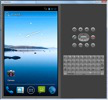Android generates user interfaces either from XML or from Java code.
Views
Creating and adding a new View to a Layout in XML

View Groups
A ViewGroupis a special view that can contain other views.
List view

Layouts
A Layout is a type of GroupView. It holds views in a certain layout on the screen.
Adding a Layout - XML example - adding to the layout XML
The layout xml is placed in <project_path>/res/layouts
Adding a Layout - Code example
This would be implemented in an Activity class.
Global Strings
A global string, or an array of strings, are declared in an external xml file in the resource folder:<project>/res/values/strings.xml
Declaring a global string
Using a global string while creating a TextView
Code usage
Code usage
Menus
Options Menu
An Options menu is presented when the user presses the menu button while the Activity is active.
Step 1 - Creating the menu XML
The layout xml is placed in <project_path>/res/menu
Step 2 – Displaying the menu (implemented in Activity class)
Step 3 – Listening to user choice (implemented in Activity class)
Context Menu
A context menu is a floating list of menu items that appears when the user performs a long-press on a View.
Step 1 - Creating a menu XML
Step 2 – Showing the menu (implemented in Activity class)
Step 3 – Listening to user choice (implemented in Activity class)
Step 4 – Attaching the context menu to a view (implemented in Activity class)

Submenu
A submenu is a floating list of menu items that the user opens by pressing a menu item in the Options Menu or a context menu.
Alerts/Dialogs
Toast
A toast notification is a message that pops up on the surface of the window.

AlertDialog

Status-Bar Notifications
One way to notify an Android user is by displaying notifications in the status bar. You can show a message, play a sound, add an icon and more.
Creating a status bar notification

Resource Images
Resource images are placed under <project_dir>/res/drawable
Using a resource image in an image view - XML example
Turning the resource image to a Bitmap object
Drawing the bitmap on a canvas object
Creating Links Using Linkfy
Linkfy is a class that lets you create links from TextViews.
You can create links not just to web sites, but to also map addresses, emails and even phone numbers.
Creating web links

You can also create links to phone numbers, map locations or email addresses.
Using a regular expressionfor filtering strings














